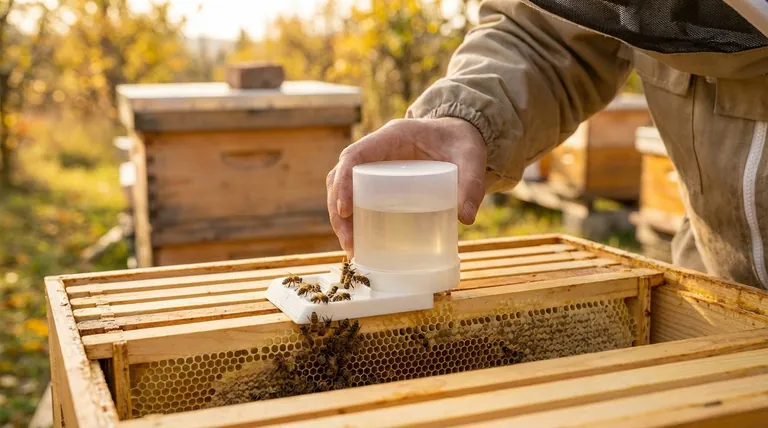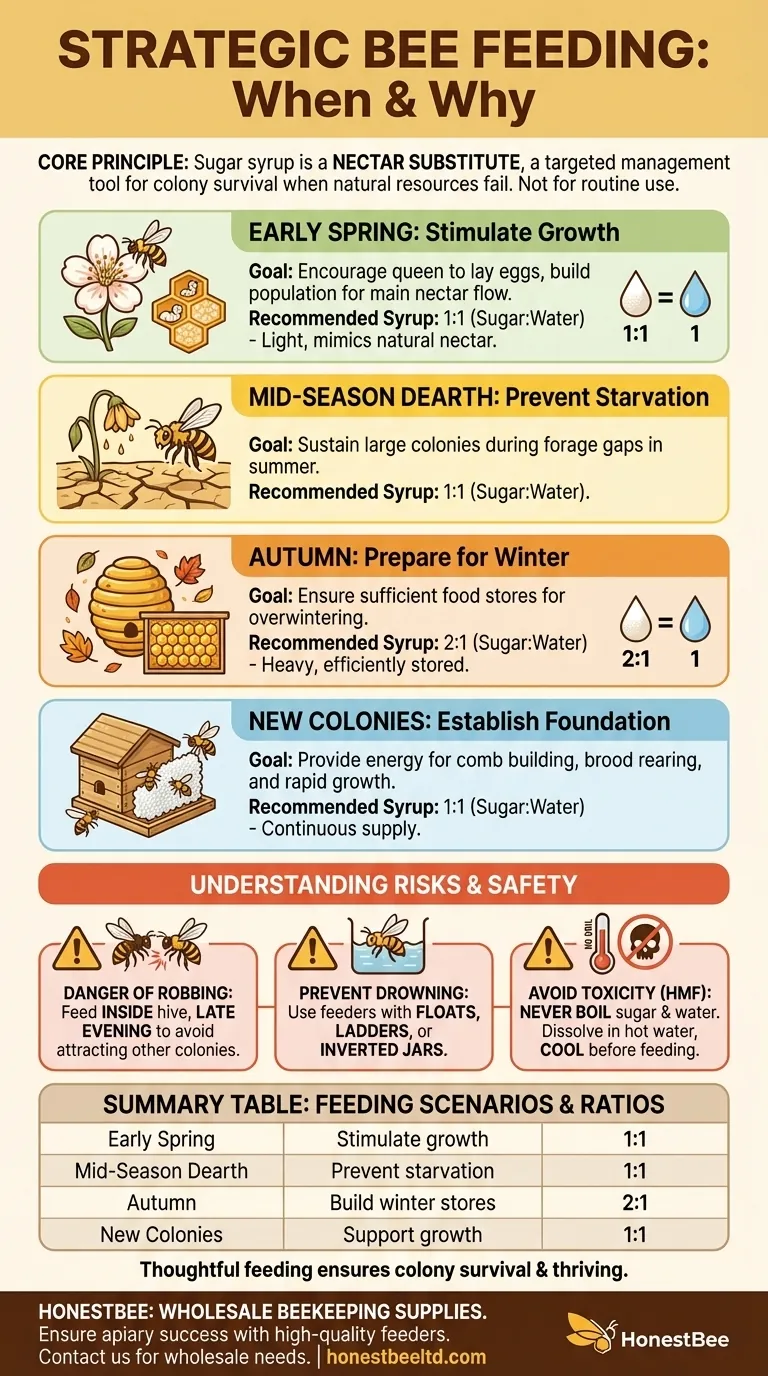Feeding sugar syrup to bees is a targeted intervention, not a routine activity. It is typically done only during four specific scenarios: in early spring to stimulate colony growth, during a mid-season nectar "dearth" to prevent starvation, in the autumn to ensure the hive has sufficient stores for winter, or when establishing a new, small colony (a nucleus hive).
The core principle is that sugar syrup serves as a substitute for natural nectar. It is a management tool used to ensure a colony's survival and strength when environmental conditions fail to provide the resources the bees need.

Why Feeding is Critical: A Nectar Substitute
Mimicking Natural Nectar Flow
Sugar syrup acts as a stand-in for nectar, the bees' natural carbohydrate source. A steady supply of carbohydrates is essential for all hive activities, from raising brood to building comb.
When natural nectar is abundant, supplemental feeding is unnecessary and can even be detrimental. The goal is to intervene only when nature falls short.
Fueling Colony Survival
A colony's survival depends entirely on its food stores. Without sufficient energy from nectar or honey, bees cannot regulate their temperature, raise new generations, or defend the hive.
Feeding provides the necessary energy to bridge gaps in natural forage, preventing a colony from starving or dwindling in population.
The Four Key Feeding Scenarios
Early Spring: Stimulating Growth
Feeding a light syrup in early spring, before the first major nectar flow, encourages the queen to begin laying eggs. This early brood-rearing builds up the colony's population so a large workforce is ready to forage when flowers begin to bloom.
Mid-Season Dearth: Bridging the Gap
Sometimes there is a period in the summer when no major nectar sources are available, known as a dearth. During this time, a large, populous colony can quickly consume its stores. Feeding is necessary to sustain the population until the next nectar flow begins.
Autumn: Preparing for Winter
After the final honey harvest, it's critical to ensure the bees have enough food to survive the long, cold winter months. Feeding a heavy syrup in the fall allows them to pack away sufficient stores to last until spring.
New Colonies: Establishing a Foundation
A new or small nucleus colony has a small workforce and no stored resources. Continuous feeding is essential to provide the energy they need to build comb, raise brood, and establish a thriving population quickly.
Understanding the Trade-offs and Risks
The Danger of Robbing
The scent of sugar syrup can attract bees from other hives, leading to a frenzy of "robbing" where the stronger colony attacks the weaker one to steal its food. This can decimate a hive.
To minimize this risk, always place feeders inside the hive and preferably in the late evening. This gives the colony time to find and control the food source before outside foragers become active.
Preventing Bee Drowning
Bees can easily drown in open pools of syrup. Common feeders like frame feeders or top feeders must have floats, ladders, or textured surfaces to ensure bees can access the syrup without falling in.
Methods like using a Mason jar with small holes in the lid, inverted over the inner hive cover, are popular because they largely eliminate the risk of drowning.
Avoiding Toxicity When Preparing Syrup
You must never boil the sugar and water mixture. Boiling sugar can create Hydroxymethylfurfural (HMF), a compound that is toxic to bees.
The correct method is to bring the water to a near-boil, remove it from the heat, and then stir in the sugar until it is completely dissolved. The syrup must be cooled to room temperature before being given to the bees.
How to Apply This to Your Hive
Strategic feeding depends entirely on your specific goal for the colony.
- If your primary focus is stimulating spring growth: Feed a thin 1:1 syrup (by weight or volume) to mimic a light nectar flow and encourage brood rearing.
- If your primary focus is preparing the colony for winter: Feed a thick 2:1 syrup (two parts sugar to one part water) to help bees efficiently build up their winter honey stores.
- If your primary focus is supporting a new or weak colony: Provide a consistent supply of 1:1 syrup until they have built out sufficient comb and established a stable population.
- If your primary focus is preventing robbing: Always feed inside the hive in the evening and reduce the entrance size of weaker colonies to make it easier for them to defend.
Ultimately, thoughtful feeding is one of the most effective tools a beekeeper has to ensure a colony not only survives but thrives.
Summary Table:
| Feeding Scenario | Goal | Recommended Syrup Ratio |
|---|---|---|
| Early Spring | Stimulate brood rearing & colony growth | 1:1 (Sugar:Water) |
| Mid-Season Dearth | Prevent starvation during forage gaps | 1:1 (Sugar:Water) |
| Autumn | Build winter food stores | 2:1 (Sugar:Water) |
| New Colonies | Support comb building & population growth | 1:1 (Sugar:Water) |
Ensure your apiary's success with the right supplies. Strategic feeding is key to hive health, and having reliable equipment makes all the difference. HONESTBEE supplies commercial apiaries and beekeeping equipment distributors with high-quality, durable feeders and essential beekeeping supplies through our wholesale-focused operations. Let us help you build stronger, more productive hives.
Contact HONESTBEE today to discuss your wholesale needs and equip your operation for success!
Visual Guide

Related Products
- HONESTBEE Entrance Bee Feeder Professional Hive Nutrition Solution for Beekeeping
- In-Hive Dual Compartment Frame Bee Feeder for Targeted Colony Nutrition
- HONESTBEE Professional Entrance Bee Feeder Hive Nutrition Solution
- HONESTBEE Round Hive Top Bee Feeder for Syrup
- Rapid Bee Feeder White Plastic 2L Round Top Feeder for 8 or 10-Frame Bee Hives
People Also Ask
- How does the entrance feeder method work? A Guide to Simple But Risky Hive Feeding
- What is a common problem with hive front feeders? Avoid Robbing Frenzies and Protect Your Hives
- How to make an entrance feeder for bees? A DIY Guide for Safe & Effective Feeding
- What is an entrance feeder? A Guide to Its Simple Design and High Robbing Risk
- What are the common types of honey bee feeders? Choose the Right Feeder for Your Hive



















